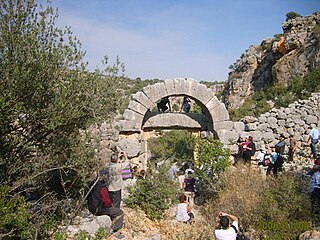Related Research Articles
Carmylessus or Karmylessos was a town of ancient Lycia, described by Strabo between Telmissus and the mouth of the Xanthus. After Telmissus, he says, then Anticragus, an abrupt mountain on which is the small place Carmylessus, lying in a ravine.
Charadrus or Charadros was a town on the coast of ancient Cilicia, between Platanus and Cragus, according to the Stadiasmus. Strabo, who writes it Χαραδροῦς, describes it as a fort with a port below it, and a mountain Andriclus above it. It is described by Francis Beaufort "as an opening through the mountains with a small river." The mountain is mentioned in the Stadiasmus under the name Androcus.
Kasara was a town of ancient Caria. Its name does not appear in ancient authors but is inferred from inscriptions.
Hydas, also known as Hyda (Ὑδά), was an inland town of ancient Caria, mentioned by Pliny the Elder.
Zephyrium or Zephyrion, also called Zephyrium on the Calycadnus to differentiate it from other towns called Zephyrium, was a town of ancient Cilicia on the Calycadnus River near its mouth, on a promontory of the same name.
Diocaesarea or Diocaesareia or Diokaisareia was a Graeco-Roman town located in Cilicia Trachea mentioned by Ptolemy and the ecclesiastical authorities. It was in time assigned to the late Roman province of Isauria. It was a bishopric; no longer the seat a residential bishop, it remains a titular see of the Roman Catholic Church.
Chadisia, also Chadisius or Chadisios (Χαδίσιος), was a town of ancient Pontus, not far from the coast on a river of the same name. Hecataeus, quoted by Stephanus of Byzantium, speaks of Chadisia as a city of the Leucosyri, that is, of the group the Persians called the Cappadocians; and he says, "the plain Themiscyra extends from Chadisia to the Thermodon." Menippus, in his Periplus of the two Ponti, also quoted by Stephanus, says: "from the Lycastus to the village and river Chadisius is 150 stadia, and from the Chadisius to the river Iris 100 stadia."
Aunesis was a coastal town of ancient Pamphylia or of Cilicia, inhabited during Roman times. It was the port of Hamaxia.
Augai or Augae was a coastal town of ancient Pamphylia or of Cilicia, inhabited during Roman times. It was located 70 stadia from Aunesis.
Ptolemais was a coastal town of ancient Pamphylia or of Cilicia, inhabited during Hellenistic times. It was located between the Melas River and Coracesium.

Korasion, also called Kalon Korakesion, was a town of ancient Cilicia, on the coast a little to the east of Seleucia ad Calycadnum, inhabited during the Roman and Byzantine eras.
Arima, also called Krine, was a town of ancient Cilicia, on the coast east of Seleucia ad Calycadnum. Arima was noted in Greek Mythology in connection with Typhon and Arima, couch of Typhoeus.
Corycium Antrum was an inland town of ancient Cilicia, above Arima, inhabited during the Byzantine era.
Kanytelis was an inland town of ancient Cilicia, inhabited during the Hellenistic, Roman, and Byzantine eras. Its name does not appear among ancient authors but is inferred from epigraphic and other evidence.
Kalanthia was a coastal town of ancient Cilicia, inhabited during the Roman and Byzantine eras.
Kouara was a town of ancient Lydia, inhabited during Roman times.
Tyanollos was a town of ancient Lydia, inhabited during Hellenistic and Roman times.
Balbissa was a town of ancient Cappadocia, inhabited in Byzantine times. The name Balbissa does not occur in ancient authors but is inferred from epigraphic and other evidence.
Thouththourbia was a town of ancient Cilicia, inhabited in Roman times. The name does not occur among ancient authors but is inferred from epigraphic and other evidence.
Gozalena was a town of ancient Pontus, inhabited during Roman times.
References
- 1 2 Richard Talbert, ed. (2000). Barrington Atlas of the Greek and Roman World . Princeton University Press. p. 66, and directory notes accompanying.
- ↑ Lund University. Digital Atlas of the Roman Empire.
Coordinates: 36°23′20″N34°04′20″E / 36.388943°N 34.072095°E
| This article about a location in ancient Cilicia is a stub. You can help Wikipedia by expanding it. |
| This about a populated place in the Byzantine Empire article is a stub. You can help Wikipedia by expanding it. |
| This geographical article about a location in Mersin Province, Turkey is a stub. You can help Wikipedia by expanding it. |